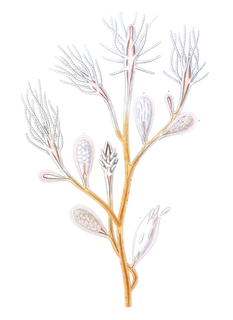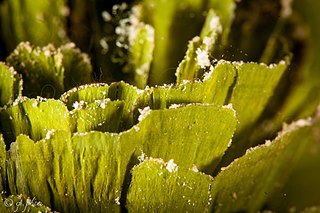 W
WAplanulata is a suborder of Hydrozoa, a class of marine and freshwater invertebrates belonging to the phylum Cnidaria. The group have lost its planula larval stage, and the only remnants of the medusa stage is when they functions as gonophores attached to the polyp.
 W
WBougainvillia is a genus of hydroids in the family Bougainvilliidae in the class Hydrazoa. Members of the genus are characterised by having the marginal tentacles of their medusae arranged in four bundles. Some species are solitary and others are colonial but all are filter feeders. They are found in the Southern Ocean, having a circumpolar distribution, but some species also occur in the Northern Hemisphere, possibly travelling there as polyps on the hulls of ships.
 W
WCandelabridae is a small family of cnidarians within the class Hydrozoa. Myriothelidae Hincks, 1868 and Symplectaneidae Fraser, 1941 are now accepted as synonyms of this family.
 W
WCapitata is a suborder of Hydrozoa, a class of marine invertebrates belonging to the phylum Cnidaria.
 W
WCordylophora is the sole genus of hydrozoans in the monotypic family Cordylophoridae.
 W
WCordylophora caspia is a species of athecate hydroid in the family Cordylophoridae.
 W
WCorymorpha is a genus of hydrozoans in the family Corymorphidae.
 W
WCorymorphidae is a family of hydroid cnidarians. For long placed in a presumed superfamily or infraorder Tubulariida of suborder Capitata, they are actually close relatives of the Hydridae and are now united with these and a number of relatives in a newly recognized suborder Aplanulata. Most, if not all species in this family grow on stalks and resemble small flowers.
 W
WCoryne is a genus of hydrozoans belonging to the family Corynidae.
 W
WCorynidae is a family of hydrozoans in the order Anthomedusae.
 W
WDistichopora is a genus of hydrozoans belonging to the family Stylasteridae.
 W
WEctopleura is a genus of hydrozoans in the family Tubulariidae.
 W
WEleutheria is a genus of hydrozoans belonging to the family Cladonematidae.
 W
WEudendriidae is a taxonomic family of hydroids (Hydrozoa). The family contains around 85 species.
 W
WThe grey fan hydroid is a large colonial hydroid in the family Solanderiidae.
 W
WHydra oligactis, also known as the brown hydra, is a species of hydra found widely dispersed in the northern temperate zone. It is a common organism found in still waters from early Spring to late Autumn.
 W
WHydractinia is a genus of commensal athecate hydroids which belong to the family Hydractiniidae. Hydractinia species mostly live on hermit-crabbed marine gastropod shells.
 W
WHydractinia altispina, or high-spined commensal hydroid, is a small colonial hydroid in the family Hydractiniidae.
 W
WHydractiniidae is a cnidarian family of athecate hydroids.
 W
WHydrichthys is a genus of colonial marine hydrozoans formerly placed in the family Hydrichthyidae but is now included in the family Pandeidae. The polyps of members of this genus are parasitic. The polyp attaches itself to a fish, and in one species exhibits hyperparasitism by attaching itself to a copepod, itself the parasite of a fish.
 W
WHydrichthys sarcotretis is a species of colonial marine hydrozoans now included in the family Pandeidae. The polyps of members of this genus are parasitic and attach themselves to a fish. H. sarcotretis is a species that exhibits hyperparasitism by attaching itself to a copepod, itself the parasite of a fish.
 W
WHydrocorella is a small genus of athecate hydroids in the family Hydractiniidae.
 W
WHydrocoryne is a genus of cnidarians belonging to the family Hydrocorynidae.
 W
WHydrocorynidae is a family of cnidarians belonging to the order Anthoathecata.
 W
WMargelopsidae is a family of cnidarians belonging to the order Anthoathecata.
 W
WMillepora dichotoma, the net fire coral, is a species of hydrozoan, consisting of a colony of polyps with a calcareous skeleton. Part of the metabolism of the fire coral relies on zooxanthellae included in their anatomy. They are found from the Red Sea to Samoa and South Africa. They form fan-shaped colonies up to 60 cm across, but clumps may be several metres across. Coloured mustard to olive-yellow, the fans form in a single plane.
 W
WMillepora platyphylla is a species of fire coral in the family Milleporidae. It is also known by the common names blade fire coral and plate fire coral. It is found from the Red Sea and East Africa to northern Australia and French Polynesia.
 W
WMillepora squarrosa is a species of fire coral that can be found in the Caribbean Sea as well as in the western Atlantic. They have a smooth surface covered in tiny pores from which polyps protrude. They can reach up to 5 centimeters in height and can range from brown or tan in color with slight purple or red tints. It is commonly known as "box fire coral", which refers to its box-like structure and the stinging sensation felt when touched with a bare hand.
 W
WOceaniidae is one of the over 50 cnidarian families of the order Anthomedusae. It contains nearly 50 species in ten genera.
 W
WOdessia is a genus of cnidarians belonging to the family Moerisiidae.
 W
WPandea conica is a species of hydrozoan in the family Pandeidae.
 W
WPandeidae is a family of hydroids in the class Hydrozoa. Like other jellyfish there is usually a mature medusa form which is pelagic and reproduces sexually and a hydroid or polyp form which is often benthic and reproduces asexually by budding.
 W
WPolyorchis, or bell jellies, is a genus of hydrozoans in the family Corynidae. They are transparent with red coloration in their internal organs and eye spots around the rim of their bell. The red pigmentation helps them camouflage. They are often found in harbors, marinas, and other calm waters close to shore. They feed on plankton and benthic crustaceans and are found near the sea floor. The bells can reach about 2.25 inches (5 cm).
 W
WPorpita is genus of hydrozoans in the family Porpitidae. It has two species recognized and is the type genus of its family.
 W
WRathkea is a genus of cnidarians belonging to the family Rathkeidae.
 W
WSarsia is a genus of hydrozoan in the family Corynidae.
 W
WScrippsia is a genus of hydrozoans in the family Corynidae. It is monotypic with only one species, Scrippsia pacifica.
 W
WSphaerocorynidae is a family of cnidarians belonging to the order Anthoathecata.
 W
WSpirocodon is a monotypic genus of hydrozoans with Spirocodon saltatrix as the only species in the genus. It is found in the north-western Pacific Ocean, and was first described in 1818 by the German naturalist and explorer Wilhelm Gottlieb Tilesius von Tilenau.
 W
WStylasteridae is a family of hydrozoans.
 W
WTubularia is a genus of hydroids that appear to be furry pink tufts or balls at the end of long strings, thus causing them to be sometimes be called "pink-mouthed" or "pink-hearted" hydroids. Their average height is 40–60 mm and the diameter of the polyp and tentacles is 10mm. Tubularia indivisa and Ectopleura larynx can be difficult to distinguish and the two often grow together. In E. larynx the stems branch while in T. indivisa they are unbranched. Tubularia occurs either solitary or in colonies. The hydrants are large, brilliantly coloured and flower like. The colony is dioecious. The gonophores or medusae remain attached to the hypostome in clusters and are never set free. This animals represents structure of the ancestral coelenterate.
 W
WTubularia indivisa, or oaten pipes hydroid, is a species of large hydroid native to the northeastern Atlantic Ocean, the North Sea, Norwegian Sea, and the English Channel. The conical solitary polyps are found on dull yellow unbranched stems that reach 10 to 15 cm in height with a diameter of 1.5 cm (0.59 in). They may be fused to a small number of other individual stems at their bases. The pinkish to red polyps resemble flowers, having two concentric rings of tentacles, with the outer rings being paler and longer than the inner ring. At the center is a pale pink gonotheca. They are preyed upon by nudibranchs.
 W
WTubulariidae is a family of hydroid cnidarians. For long placed in a presumed superfamily or infraorder Tubulariida of suborder Capitata, they are actually close relatives of the Hydridae and are now united with these and a number of relatives in a newly recognized suborder Aplanulata. Most if not all species in this family grow on stalks and resemble small flowers.
 W
WTurritopsis is a genus of hydrozoans in the family Oceaniidae.
 W
WTurritopsis rubra is a species of hydrozoan of the family Oceaniidae.
 W
WZancleidae is a family of cnidarians belonging to the order Anthoathecata.
 W
WZyzzyzus is a genus of marine tubulariid hydrozoans, which grow embedded in sponges.